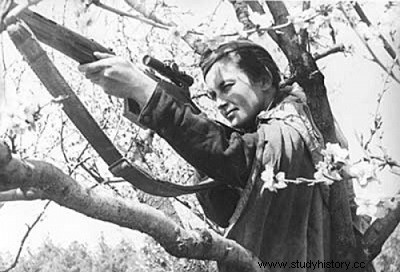
Lyoudmila Mikhaïlovna Pavlichenko or Lioudmyla Mykhailivna Pavlichenko (July 12, 1916 – October 10, 1974) was a Soviet sniper of World War II.
Credited with 309 enemy kills, she was honored with the title of Hero of the Soviet Union.
Born in Bila Tserkva, in the Ukrainian SSR, on July 12, 1916, Lioudmila Pavlichenko moved to kyiv with her family at the age of 14. She joined a shooting club and became a sniper, while working as a worker at the Arsenal factory in kyiv.
In June 1941, while studying history at kyiv University, Nazi Germany began to invade Soviet territory. She was among the first volunteers to come to the recruiting office and ask to fight in the infantry. She was assigned to the 25th Infantry Division of the Red Army.
There she became one of 2,000 female Red Army snipers — only 500 of whom were still alive at the end of the war. She killed her first two enemies near Beliaevka, with a manual repeating Mosin-Nagant rifle, fitted with a P.E. 4 scope.
Pavlichenko fought for two and a half months near Odessa, where she killed 187 enemies. When the Germans took control of Odessa, his unit was sent to Sevastopol on the Crimean peninsula. In May 1942, Lieutenant Pavlichenko was cited in the Southern Army Council for killing 257 German soldiers. His total confirmed World War II score is 309, including 36 enemy snipers. In June 1942, Pavlichenko was wounded by mortar fire. Due to her growing celebrity, she was withdrawn from the front less than a month after her recovery.
In September 1942, she was sent to Canada and the United States and was received at the White House by President Franklin Roosevelt, becoming the first Soviet citizen to be received by a President of the United States. Lyoudmila Pavlichenko was invited by Eleanor Roosevelt to tour the United States to recount her experiences. She appeared before the International Student Assembly meeting in Washington, took part in rallies of the CIO labor confederation and gave speeches in New York. The United States gave him a Colt automatic pistol. In Canada, she received a Winchester sniper rifle, which is currently on display at the Central Museum of the Armed Forces in Moscow. While in Canada with Vladimir Pekhelintsev, another sniper, and Nikolai Krasavchenko, head of the Moscow Youth Organization, thousands of people greeted them at Union Station in Toronto. She then went to Great Britain.
Having reached the rank of major, Pavlichenko was not returned to combat and devoted herself to training Soviet snipers until the end of the war. In 1943, she was awarded the Hero of the Soviet Union gold medal and was honored with a Soviet postage stamp bearing her likeness.
After the war, she completed her studies at the University of kyiv and began a career as a historian. From 1945 to 1953, she worked as an assistant researcher at the headquarters of the Soviet Navy. She then took an active part in the Soviet Committee of War Veterans.
Death
Lioudmila Pavlichenko died on October 10, 1974 in Moscow, at the age of 58. She is buried in the Novodevichy cemetery.
In 1976, a second postage stamp was issued in his honor in the USSR, and a Ukrainian cargo ship was named after him.
